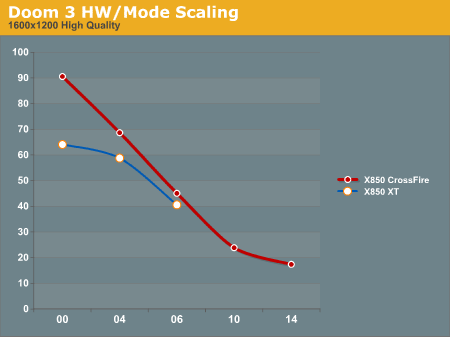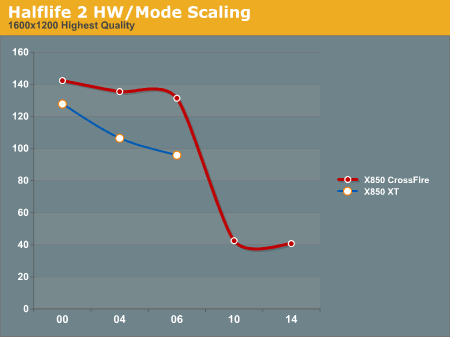ATI's X8xx CrossFire Graphics Arrive
by Derek Wilson on September 26, 2005 1:00 PM EST- Posted in
- GPUs
Mode and Hardware Scaling
There are two scaling factors we want to pay attention to here. First, we will be looking at how CrossFire scales with AA mode. As 8x and 10x share the same performance numbers (as do 12x and 14x), we will be looking at: no AA, 4xAA, 6xAA, 10xAA, 12xAA modes. We will be able to see just how steeply Super AA modes drop off in this test.We will also be looking at single card performance. It will be important to compare these numbers to the Super AA numbers, as each card in Crossfire mode should ideally be able to render the entire scene at single card speeds. Any difference between the Super AA modes and a single card running at either 4x or 6x AA account for the overhead of the communication system and compositing engine. The performance drop in these modes is more pronounced than in the other modes, as each card needs to render the entire scene at full frame rate. Any latency or bandwidth limitations will show up more easily here.
Our graphs show frames per second on the y-axis and AA mode across the x-axis.

Doom 3 shows a good performance increase due to CrossFire at standard AA settings. Both the single card and CrossFire setup are similarly GPU limited as AA increases. The drop from 4xAA on a single card to 10xAA on CrossFire is nearly 50%.
When we take a look at Half-Life 2, we see that a single card is fairly GPU limited with increasing AA while CrossFire handles it well. Going from single card AA modes to CrossFire Super AA modes shows more than a 50% drop in performance. This is likely due to the fact that as framerate increases, the impact of latency and bandwidth restrictions on transferring fully antialiased scenes from the slave to the master is proportionally greater.

Here's a look at how going from a single to a two card configuration scales under NVIDIA and ATI hardware under the games we tested.
| Multi GPU % Performance Improvement (16x12 noAA) | |||
| Doom 3 | Battlefield 2 | Half-Life 2 | |
| CrossFire | 41.3 | 53.8 | 15.8 |
| SLI | 34.0 | 89.3 | 22.2 |
| Multi GPU % Performance Improvement (16x12 4xAA) | |||
| Doom 3 | Battlefield 2 | Half-Life 2 | |
| CrossFire | 69.2 | 63.6 | 35.5 |
| SLI | 81.3 | 89.3 | 68.8 |
While Crossfire performs reasonably well without AA, the 4xAA modes show that SLI provides better scaling. More importantly, though, the lack of support for higher resolutions - as well as 1600x1200 at higher refresh rates - becomes a serious limitation of Crossfire. 7800 GTX SLI running at 2048x1536 has no competition from any ATI configuration for the time being.










76 Comments
View All Comments
DerekWilson - Tuesday, September 27, 2005 - link
Actually, we took our time. Copied a few numbers down incorrectly. Sorry about that.Googer - Monday, September 26, 2005 - link
Why hasn't anyone tested these on an nForec 4 motherboard yet? ATL Crossfire on a DFI SLI motherboard, will it work?OvErHeAtInG - Monday, September 26, 2005 - link
Um, no. In the future, with different drivers? Who knows. But nvidia is unlikely to provide good nF4 drivers for people who are buying ATI cards?Live - Monday, September 26, 2005 - link
How is the total power draw calculated, before or after the PSU?DerekWilson - Monday, September 26, 2005 - link
Sorry I didn't explain -- I'll add the infopower draw is measured before the PSU -- so yes, the dissipated power of the supply itself is included. And I do know that power draw at the wall is not exactly linear with respect to power supplied to the computer. At the same time, watts pulled from the wall are what we pay for right? :-)
Dangher - Monday, September 26, 2005 - link
You do realise that without proper homework you are just perpetuating sensationalism, right? The TMDS receiver has nothing to do with actual framerate or screen refresh, you do know that, right? You are aware that 1600x1200@60Hz in the TMDS translates into about 2500x1500@100Hz when doing SLI (or Crossfire, as is the case), right? Now go do your homework and correct the article (you're liable to be sued for libel by ATI btw).overclockingoodness - Monday, September 26, 2005 - link
LOL, you are such an idiot. AnandTech can't be sued for libel; did you ever take business 101? Apparently not. Please keep your mouth shut on the things you have no clue about.DerekWilson - Monday, September 26, 2005 - link
sorry m8, don't know where you got your info, but regaurdless of the fact that it is possible for the output to be run at a higher resolution than the TMDS receiver doesn't matter when the product manager of CrossFire at ATI states that the output of CrossFire will be locked to 1600x1200@60Hz *because* of the single link TMDS receiver.I'm sorry if I didn't make it completely clear that ATI could decouple their output from the reciever but they have chosen not to.
Pete - Monday, September 26, 2005 - link
The TDMS receiver is specced to the TDMS transmitter on the slave card, so it is indirectly tied to the screen refresh. I don't recall Derek saying it limits the frame rate, but obviously you can't see more frames than screen updates, so it can potentially limit the visible framerate, too. Yes, that applies to anything with a different frame than refresh rate, but XFire is fairly limited at 16x12@60Hz.And, no, you don't double up TDMS rates with XF, as the CE (Compositing Engine) doesn't have a buffer to accomodate a refresh rate independent of TDMS rate (which is, again, limited to 16x12@60Hz).
Dangher - Monday, September 26, 2005 - link
It is late and I can't be bothered to look for the techie article on this particular problem and why it's been blown out of proportion, but I will do it tomorrow and post a link here. My apologies to Derek if I offended him, it really is late. Link upcoming.